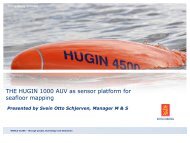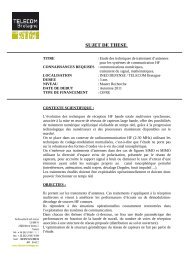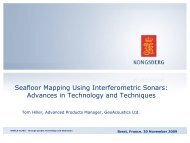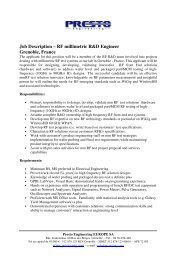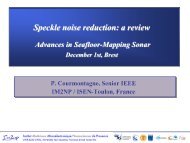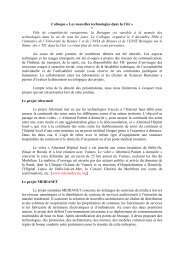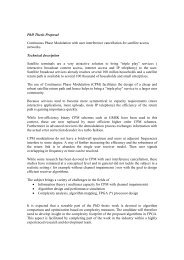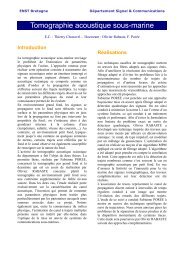Département Réseau, Sécurité et Multimédia Rapport d'Activités 2008
Département Réseau, Sécurité et Multimédia Rapport d'Activités 2008
Département Réseau, Sécurité et Multimédia Rapport d'Activités 2008
You also want an ePaper? Increase the reach of your titles
YUMPU automatically turns print PDFs into web optimized ePapers that Google loves.
working group, in order to initiate discussionon the choice of the transport protocol.ConclusionThe project will finish at the end of <strong>2008</strong>, andwe cover several IEEE 802.21 issues. Thestudy of Layer 2 handover in different accesstechnologies (IEEE 802.11, 802.16) and theusage of MIH functions allow to performefficient and seamless handover. In order totransport the MIH messages, which mayinclude decision policies, we study availabl<strong>et</strong>ransport protocols. SCTP seems to be a goodcandidate in terms of security, reliability,multihoming and mobility support.References[1] Richard Rouil, IEEE 802.16implementation in NS-2,http://w3.antd.nist.gov/[2] Richard Rouil, Nada Golmie, AdaptiveChannel Scanning for IEEE 802.16e, MilitaryCommunications Conference (MILCOM 2006),Oct. 2006, Washington, DC[3] Nicolas Montavont, Badii Jouaber, andRichard Rouil. “Gemoth technical report”,https://labo4g.enstb.fr/twiki/pub/Labo4G/Proj<strong>et</strong>sGemoth/gemoth-technical-report.pdf.Mobility and Multihoming: interaction and benefitsResearch Staff : Nicolas Montavont – Ph.D. Student: Amine DhraiefKeywords : h<strong>et</strong>erogeneous access n<strong>et</strong>works, IPv6, multihoming, mobile IPv6Applications : ITS, transportationPartners & Funding : Region Br<strong>et</strong>agneIntroductionA new digital but especially wireless world isknocking at the door. Wireless technologiesoffer now high performance and allow to g<strong>et</strong>rid of cable. However, there is no singlecommunication technology that can puttog<strong>et</strong>her all users needs, such as widecoverage areas, high data rate and support formobility. Instead, terminals integrate severalmeans of communication, which allow takingadvantage of each independent technology.This results in multihomed terminals that canaccess n<strong>et</strong>work resources through differentroutes. Multihoming is an important featur<strong>et</strong>hat allows to distribute communication flowsover a s<strong>et</strong> of paths (or interfaces), or torecover upon failure. However, while IPv6offers a framework for multihoming, standardsystems do not take as many benefits asmultihoming can offer.This project is tackling this problem byenabling a full multihoming support, especiallyin a mobile context. The typical scenario that isconsidered is a mobile n<strong>et</strong>work, which canaccess the Intern<strong>et</strong> via different paths anddistribute its traffic according to a s<strong>et</strong> ofpreferences. Location management, failurediscovery or flow redirection are some of theissues this project is focusing on.This work is conducted in the framework of theMoshi PhD project (MObility and SHIm) fundedby région Br<strong>et</strong>agne. It began in September2006.Prefix delegation2001:660:7301:3728/642001:660:220:101/64ISP1Address 1 = 2001:660:7301:3728:250:daff:fede:f7b4Address 2 = 2001:660:220:101:250:daff:fede:f7b4Address 3 = 2001:660:220:102:250:daff:fede:f7b4RealizationIntern<strong>et</strong>ISP2Prefix delegation2001:660:220:102/64IPv6 prefix Interface identifierDuring the first year of the project, we studiedthe bibliography and evaluated severalprotocols (SHIM6, HIP, SCTP). This evaluationmade us choose SHIM6 as the basic protocolfor the remaining work. SHIM6 was chosenPracom’s Annual Report <strong>2008</strong> 27



